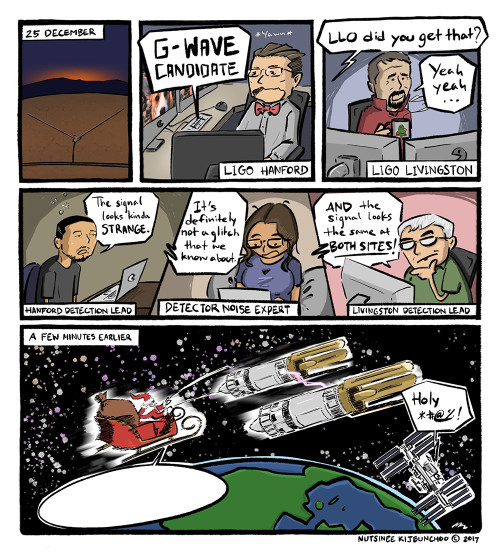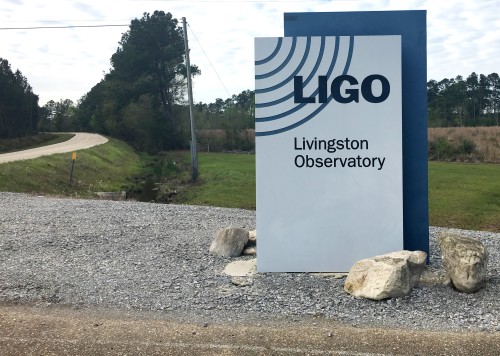Tag archives: LIGO
A very LIGO Christmas
By Tushna Commissariat
Every December, we like to do something special for you, dear readers, as the year draws to an end. As you are undoubtedly aware, some of the most exciting news in physics this year came from the world of gravitational-wave research and multimessenger astronomy, in the first ever observation of a neutron-star merger. Indeed, this global discovery bagged our 2017 Breakthrough of the Year award, while the pioneers of gravitational-wave astronomy won this year’s Nobel prize in physics.
View all posts by this author | View this author's profile
Meteoroid seen from space, Nobel laureates speak their minds on group awards and keeping up with technology
By Hamish Johnston
Fix your eyes on the upper-right portion of the above video and pay particular attention about seven seconds into the footage. You will see a fireball falling through Earth’s atmosphere. The video was taken from the International Space Station by the Italian astronaut and prolific photographer Paolo Nespoli.
Was the fireball a piece of space junk, or perhaps a tiny piece of asteroid? And how fast was it moving? For an analysis of what Nespoli may have seen, go to: “The backstory: Paolo spots a meteoroid from the ISS”. There you will also find a fantastic gallery of photographs taken by Nespoli.
View all posts by this author | View this author's profile
LIGO bags another black-hole merger

The other ones: five observed black-hole mergers, plus a possible merger shown with dashed outlines (Courtesy: LIGO)
By Hamish Johnston
They have done it again. Physicists working on the LIGO gravitational-wave detectors in the US have announced the observation of another black-hole merger.
This event was spotted on 8 June 2017 and involved two black holes combining to form a black hole 18 times more massive than the Sun. The Virgo detector in Italy did not see the event because it was not switched on. This is the fifth observation of gravitational waves from merging black holes seen by LIGO, which along with Virgo also detected a signal in August from the merger of two neutron stars. Unlike the neutron-star event, no electromagnetic radiation was seen from the merger.
View all posts by this author | View this author's profile
How does LIGO detect gravitational waves?
By Hamish Johnston
This year’s physics Nobel prize has gone to three physicists who pioneered the LIGO observatory, which in 2015 made the first-ever detection of gravitational waves.
The LIGO detectors are famously capable of detecting changes in length smaller than one thousandth the diameter of a proton.
So how is this done?
View all posts by this author | View this author's profile
LIGO–Virgo comments on neutron star rumours, sort of
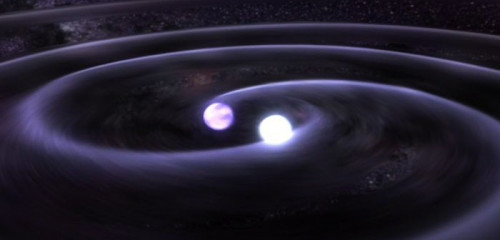
Caught in the act: has LIGO–Virgo detected merging neutron stars? (Courtesy: NASA)
By Hamish Johnston
Have gravitational waves from merging neutron stars been detected for the first time?
Physicists working on the LIGO and Virgo gravitational-wave detectors have issued a statement that appears to be a response to rumours that both gravitational waves and electromagnetic radiation from an astronomical event have been detected.
LIGO has already detected gravitational waves from three different binary black-hole mergers. But none of these events appeared to emit electromagnetic radiation that could be detected by astronomers using telescopes on Earth or in space.
View all posts by this author | View this author's profile
Ravens at LIGO, stained-glass physics, fake space pics
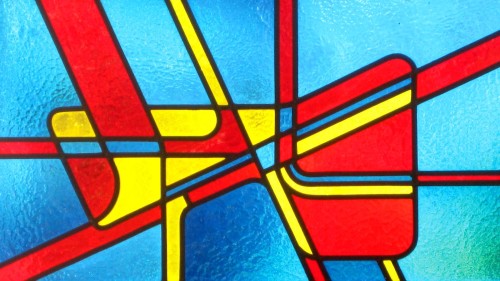
Grand designs: Los Alamos physicist Hubert van Hecke combines his hobby of stained-glass windows with physics. (Courtesy: Hubert van Hecke)
By Michael Banks and Sarah Tesh
Researchers working on the Laser Interferometer Gravitational-Wave Observatory might be answering some of the biggest questions in astrophysics, but last week they had a rather more down-to-Earth problem to solve. When spurious glitches were picked up by the detector characterization group at the LIGO detector based in Hanford, Washington, they went on an investigation to find the culprit. The team suspected that ravens were to blame as they had been seen causing mischief on tubes that vent nitrogen gas. These pipes are connected to the vacuum enclosure and any vibration could change the optical path length of light that is scattered from the test mass and reflected back. Upon closer inspection, LIGO researchers found peck marks that were “consistent with the size of a raven’s beak”. Not content with just watching the birds at play, the team even performed “simulated pecking” to see how this affected the machine’s performance. With the culprit now identified, you will be pleased to hear that the lines are set to be insulated to fend off the birds. “I guess we can’t blame [the ravens] for desiring ice on a hot desert afternoon,” writes Robert Schofield in a LIGO logbook post.
View all posts by this author | View this author's profile
How LIGO got the word out about gravitational waves
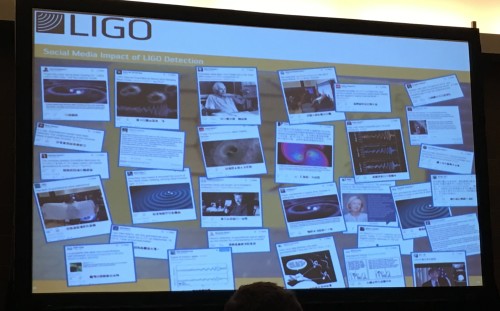
Tweeting to millions: LIGO made a social-media plan before announcing the detection. (Courtesy: Sarah Tesh)
By Sarah Tesh
Nowadays, social media plays a big role in communicating science to the public. It has two important qualities – it’s free and it’s international. A great case study for social media and science came last year when the Laser Interferometer Gravitational-Wave Observatory (LIGO) announced the first ever detection of gravitational waves. To tell us more about how the team grabbed the public’s attention (and got its work on Sheldon Cooper’s T-shirt in The Big Bang Theory), LIGO scientist Amber Stuver gave a witty talk at the APS March Meeting 2017 about the outreach strategy.
She began by telling us the story of that exciting detection day. Before the first detection, LIGO had published 80 papers on “detecting nothing”. Yet on 14 September 2015 – the first morning of the first day of Advanced LIGO – the much-sought-after signal appeared. The first thing that had to be done was to check it wasn’t a fake. Having detected nothing for so long, those with the knowledge to do so would sometimes “inject” results to check the system worked and keep the scientists on their toes.
View all posts by this author | View this author's profile
Physics World visits LIGO Livingston
By Tushna Commissariat and Sarah Tesh at LIGO Livingston, Louisiana, US
Being a journalist can be a busy and often stressful job, especially as deadlines loom fast and furious. But one of the best perks of the job is the chance to meet some amazing people and visit some of the best scientific facilities in the world. As most regualr readers of Physics World will know, we – Sarah and Tushna – have been in New Orleans, Lousiana for the APS March Meeting 2017. And it just so happens that about a two-hour drive away from New Orleans lies one half of one of the most advanced experiments in the world – the Laser Interferometer Gravitational-wave Observatory (LIGO) at Livingston.
View all posts by this author | View this author's profile
Live space station upgrade, more zombie physics, T-shirts for LIGO

Working in space: A still image from the NASA spacewalk video. (Courtesy: NASA)
By Hamish Johnston
NASA is live streaming a video of a spacewalk on its Facebook page, and you just might be able to catch it live from the International Space Station – or watch it again. The video shows astronauts Shane Kimbrough and Peggy Whitson upgrading the space station’s power system – and it looks like hard work to me.
View all posts by this author | View this author's profile
Waking up to a gravitational wave
By Hamish Johnston
Yesterday we announced the winner of the Physics World 2016 Breakthrough of the Year, which went to the LIGO Scientific Collaboration for its revolutionary, first ever direct observations of gravitational waves. I caught up with six LIGO scientists in the above video Hangout and asked them what it was like when they first realized that they had detected gravitational waves emanating from two coalescing black holes 1.3 billion light-years away.
View all posts by this author | View this author's profile
